A Texas-style crevice garden – and neighborly collaboration – brings midcentury Austin home to vibrant life
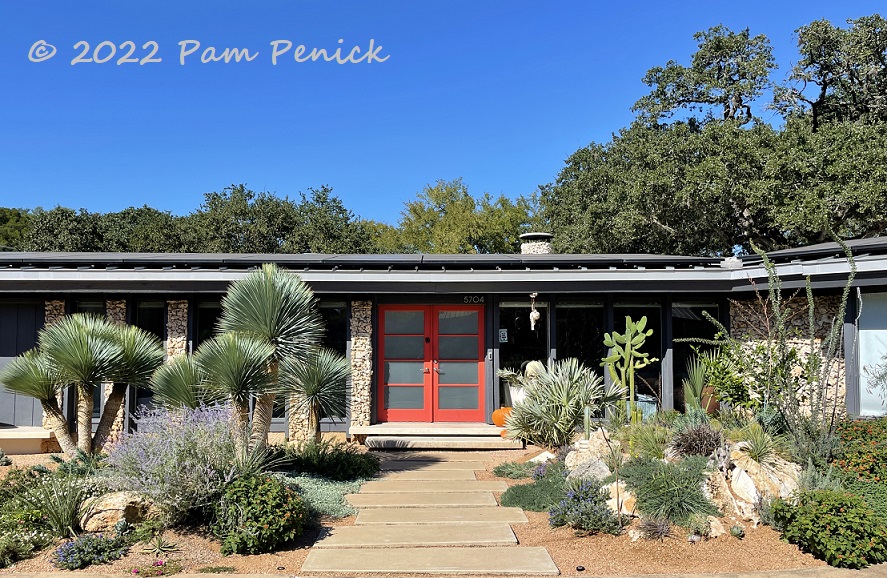
At the end of October, when Loree of Danger Garden was in town for her Garden Spark talk, we finagled an invitation to the tropicalesque garden of John Ignacio. John in turn introduced us to his friend and neighbor Coleson Bruce, who kindly allowed a couple of strangers to come see his Austin-meets-Palm Springs garden near Bull Creek in northwest Austin.
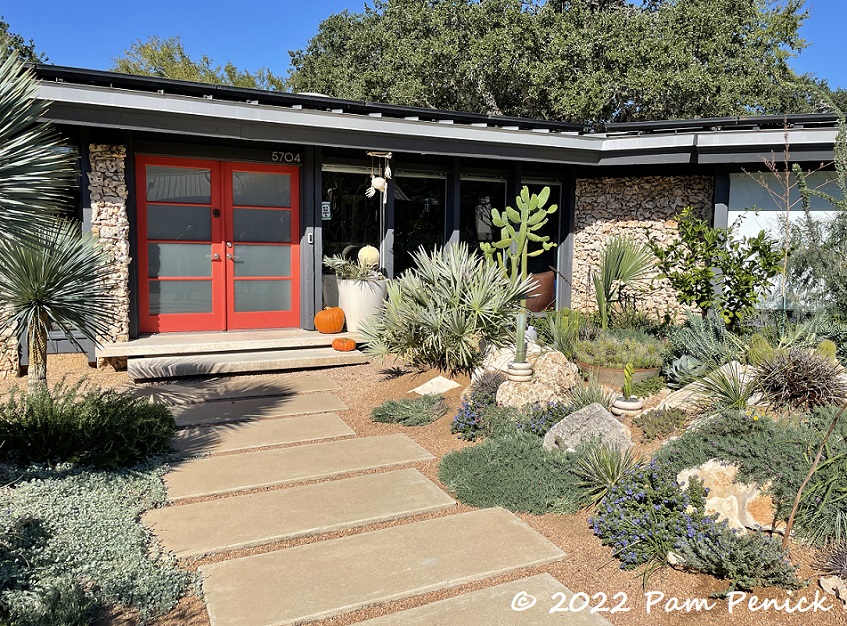
A few things make this one of the more special gardens I visited last year:
- Two artfully constructed and Texas-appropriate crevice gardens anchor the front yard. I’ve seen a few crevice gardens in private gardens in Colorado and at botanical gardens (including Denver, Betty Ford, and Kew), where the focus is on alpine plants. But I’d never seen a large-scale crevice garden in Austin, nor one with plants that can thrive in our brutally hot summers plus humidity plus occasional killing freezes.
- The garden was built during an intensive, 6-month collaboration between friends, and who doesn’t love to see that? John shared his extensive plant knowledge, expertise, and even his plants, and Coleson — a busy lawyer with a young family, who’d never picked up a trowel — soaked it up like a sponge and applied his own artistic eye toward making it spectacular. The two did the work themselves, even placing the largest rock slabs in the crevice gardens.
- Coleson’s house sits high across the road from Bull Creek, and beyond the creek, the tall limestone bluff of the Balcones Escarpment is visible. Also, the midcentury house is uniquely faced with fist-sized, honeycomb limestone rock (often called holey rock). Both the natural and manmade rockwork make the stone-heavy crevice gardens feel inevitable rather than plunked down in a softer landscape.
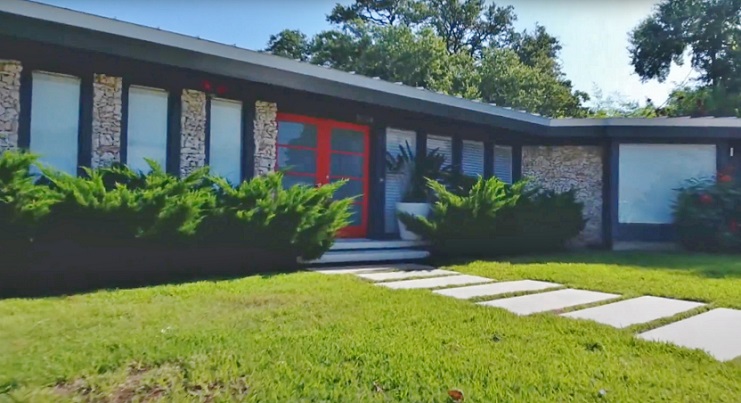
To see where Coleson started, here’s a 2016 image from a realtor listing, before he moved in. Shaggy junipers crowd the foundation, and otherwise it’s just uninspiring lawn. The modern, concrete-slab walk and floating steps remained, but everything else got pulled out.
Island crevice garden
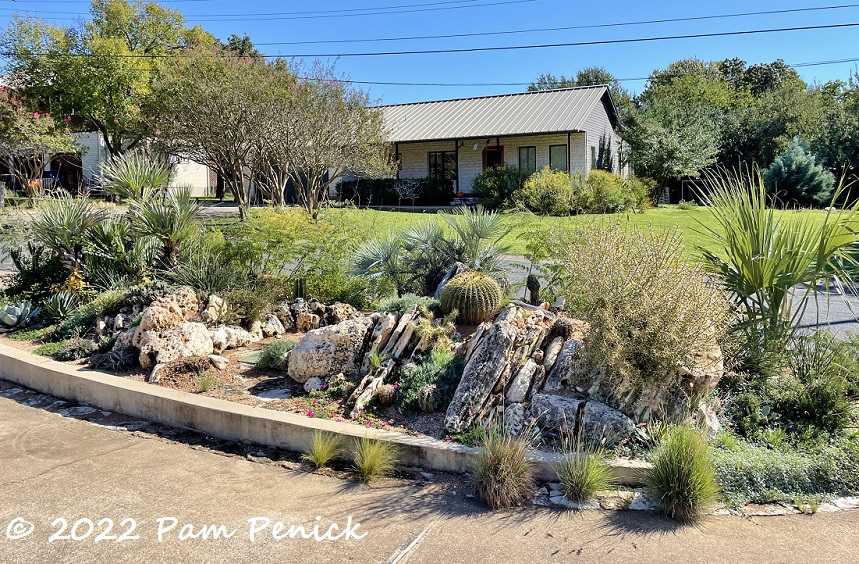
Let’s turn around to see what visitors see when they first arrive: a large crevice garden in a canoe-shaped island bed between the circular drive and street. Palms dot the outer edge of the bed, presumably to screen the road as they grow.
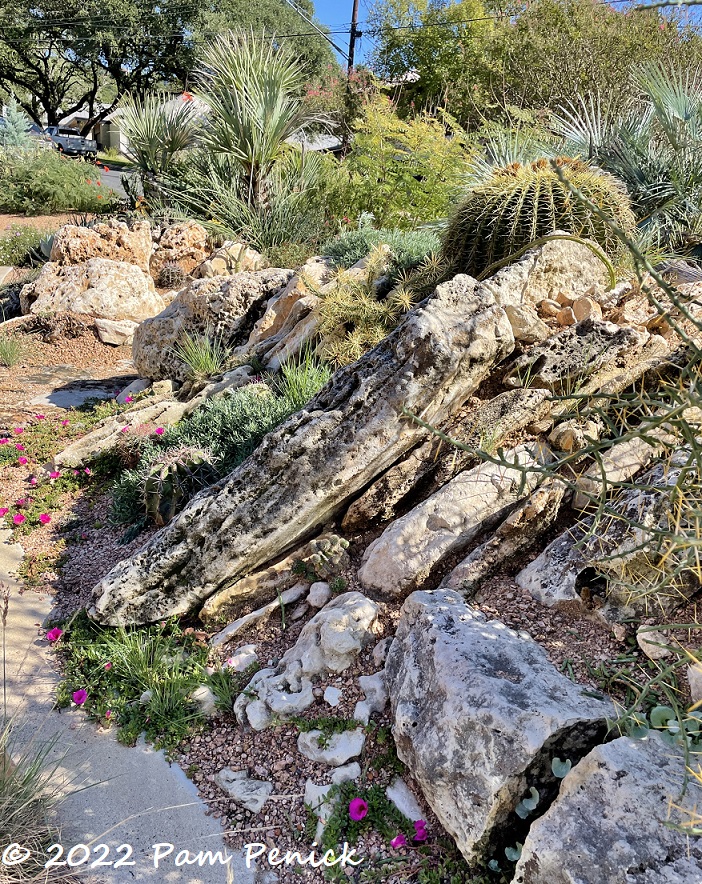
Uplifted slabs of limestone nestle on the diagonal, with chunks of holey rock and decomposed granite filling the gaps. Barrel cactus, cholla, little grasses, and moss rose (portulaca) soak up the Texas sun and thrive with roots dug into the cool crevices.
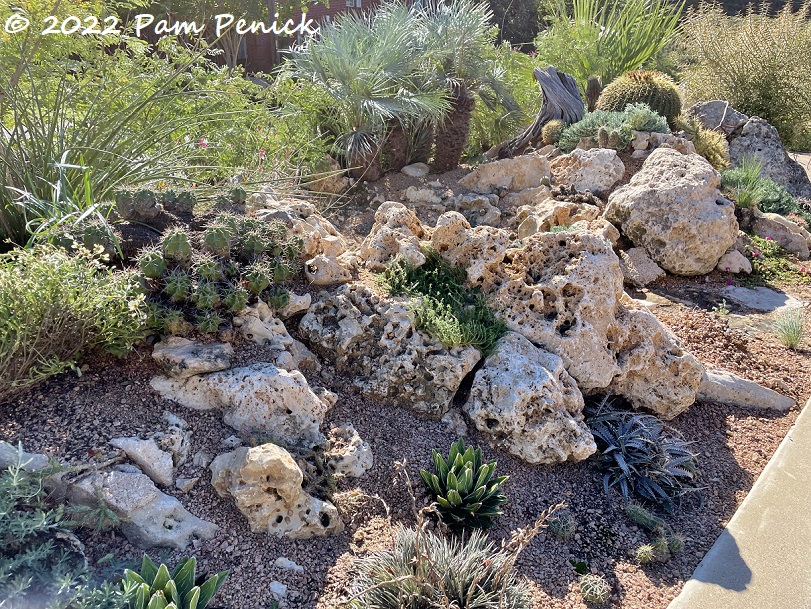
I asked Coleson what inspired his vision for the garden, and I’ll quote from his detailed reply:
“I have some background in desert biology (having lived in the Mojave over 20 years ago as an assistant park ranger) and in sculpture (working with bronze and clay, purely as a hobby and creative outlet). The desert rat and sculptor in me were drawn to the idea of, in essence, a succulent-heavy rock sculpture.
I have vivid memories of working in the granite mountain range of the Mojave, where from a quarter-mile away the fluorescent flowers of a single echinocereus (claret cup or hedgehog cactus) mound would seem to light up a whole valley. Having a touch of that outside my front door was certainly part of the garden’s vision. Each of my two crevice gardens prominently feature their own giant echinocereus mound, and by no accident!”
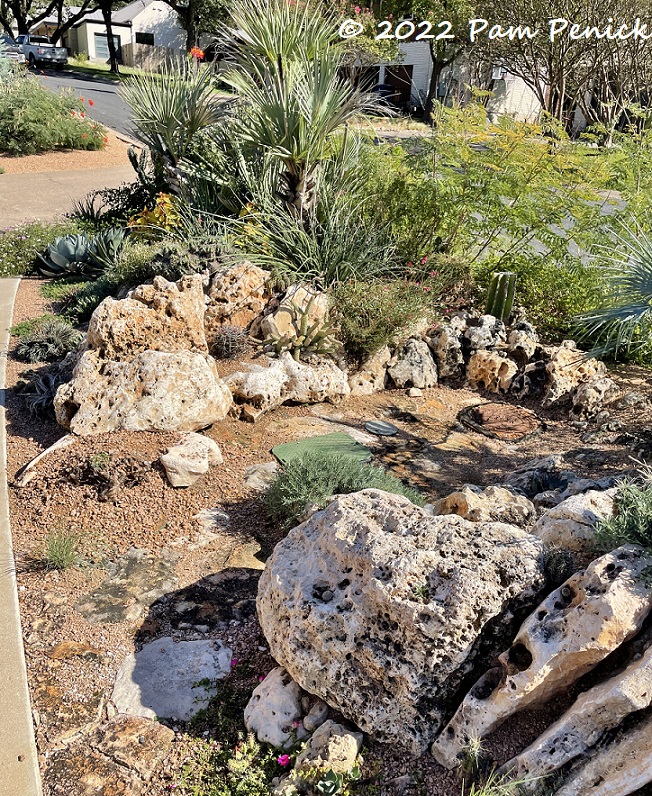
In the center of the bed, I noticed a clever solution to a common gardening obstacle, irrigation valve boxes or water meter lids: leave access so maintenance can be done and workers don’t crush your plants, and build rock edging around it.
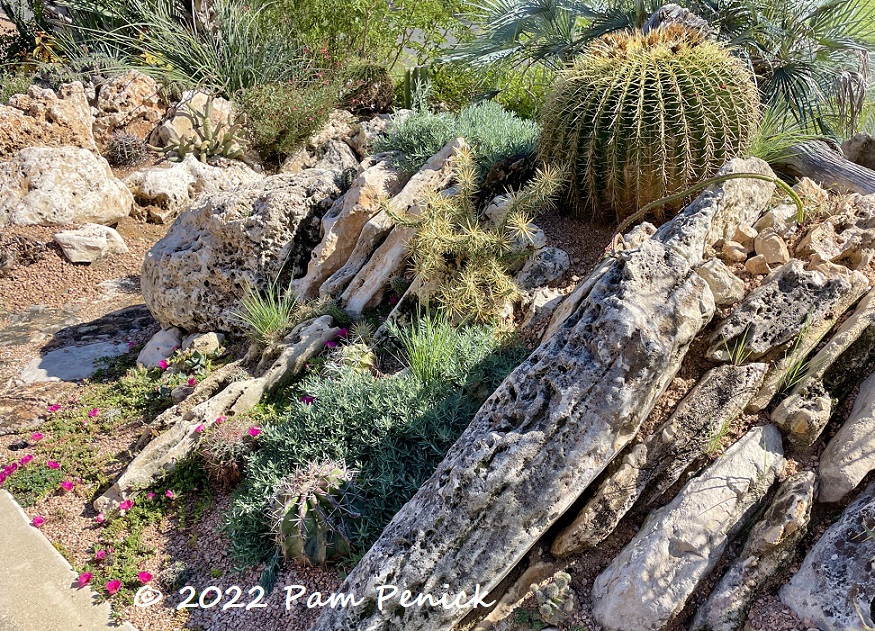
I asked Coleson how he learned to construct his Texas-style crevice gardens, and he explained:
“Around 2018 John introduced me to the idea of crevice gardens, and after that the vision of a crevice garden in my front island rattled around my head. I dived into YouTube. Several prominent names in crevice gardens have online videos regarding construction techniques, theory, etc. While attracted to the traditional alpine focus in both stone and plant selection, I wanted (or needed) a more Central Texas version. So I took what I’d learned and pivoted toward desert plants and Texas limestone rockwork.
The two crevice gardens in my yard collectively incorporate a few tons each of Texas limestone, with stones ranging from fist-sized to a quarter-ton. The larger stones were delivered as near as possible by forklift. From there the rocks were put in their final positions by equal parts ingenuity, manpower, and poor judgment. At one point there was a two-week break to allow my back to heal from some bad decisions.
On the topic of rockwork and crevice construction, there’s a secret I learned and would like to share: you must be willing to take it all apart and start over. A few times after I’d built significant portions of the rockwork, I’d sleep on it and later realize it simply wasn’t correct, aesthetically. I’d tear apart the offending portions and edit. Once or twice, out of laziness, I’d try and ignore an issue, and then John would inevitably say, ‘Does that look right?’ thereby confirming my private suspicions and also motivating me to get it right. Looking at my garden today, I can see in my mind a dozen prior variations that, had I not been willing (or convinced) to bust apart and start over, would have resulted in a lesser garden.”
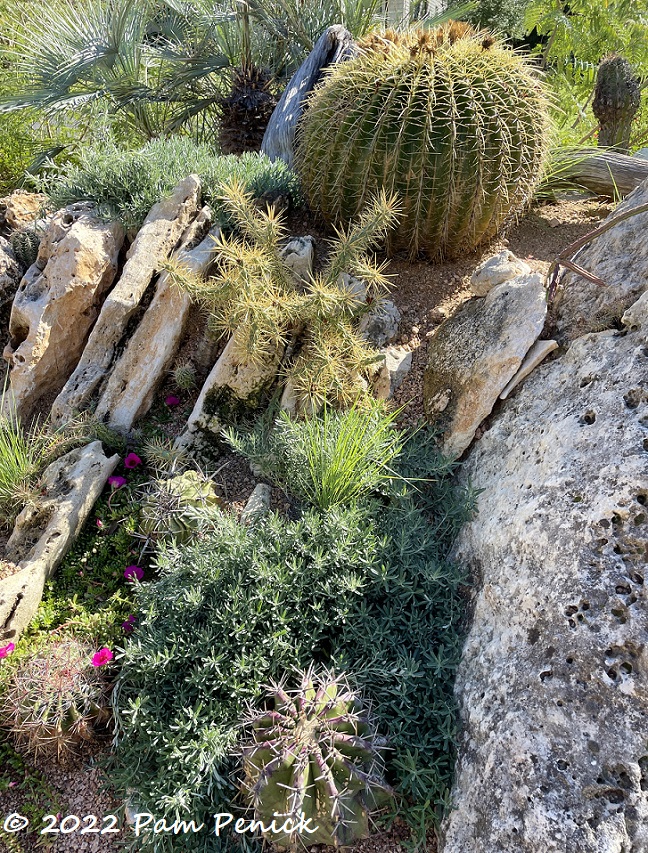
In addition to cacti hardy to our zone 8b, the crevice gardens include…
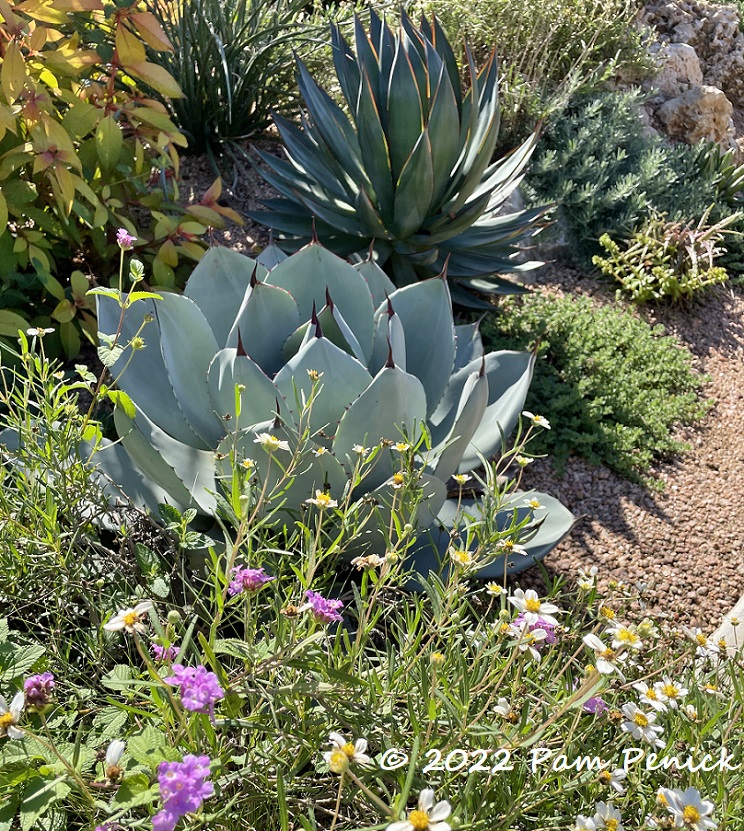
…small agaves like artichoke (A. parryi var. truncata), ‘Blue Glow’, and ‘Quadricolor’, as well as heat-loving perennials like blackfoot daisy, firebush (Hamelia patens), purple trailing lantana, and silver ponyfoot.
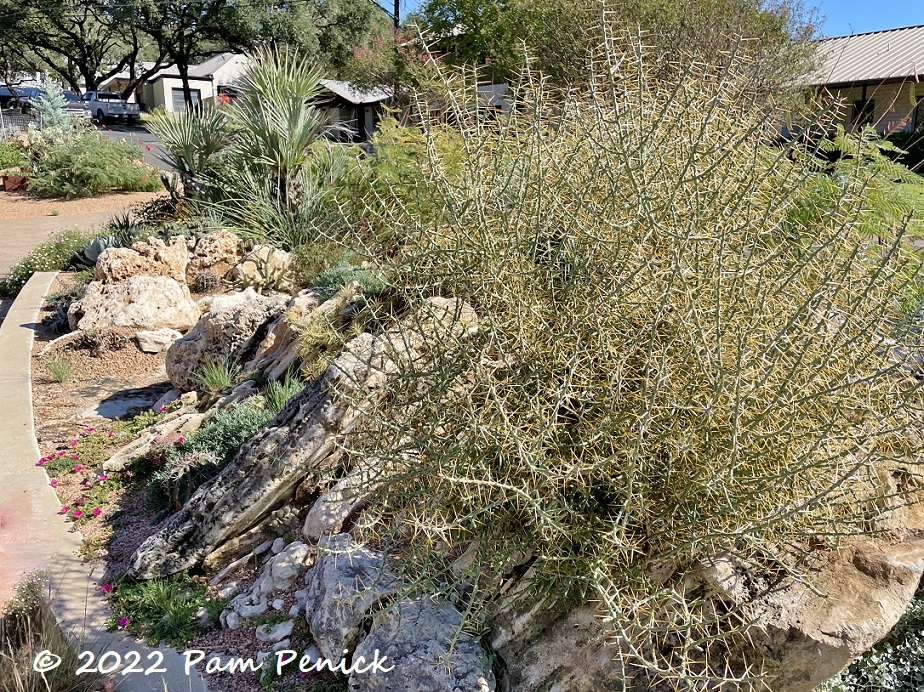
I’d never seen golden-spined Christmas cholla, also called tasajillo (Cylindropuntia leptocaulis) — except at John’s garden, of course.
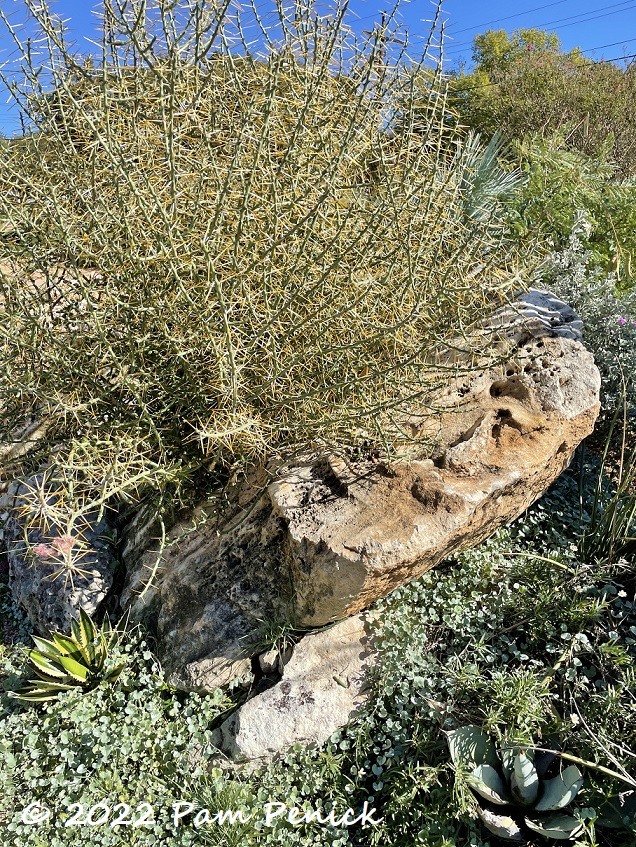
Coleson says John shared plants with him freely:
“I ‘inherited’ a significant portion of my plants from John. His home and his thousands of square feet of greenhouses have for decades been the academic collection of a mad plant scientist. So, while constructing my gardens, we were often just ‘shopping’ through John’s gardens and walking them a few streets back into my yard. I view my gardens as an extension of his collection.”
Desert-style entry garden
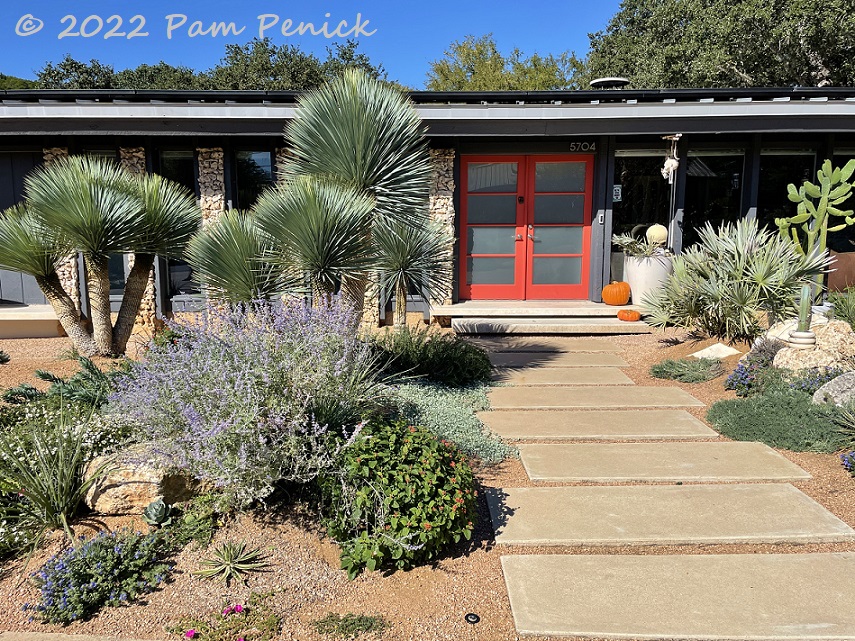
If you can tear yourself away from the island crevice garden, another awaits you to the right of the red front doors. It’s balanced on the left by bristling Yucca rostrata softened by salvia, lantana, gopher plant, blackfoot daisy, and silver ponyfoot, all mounded up with limestone boulders.
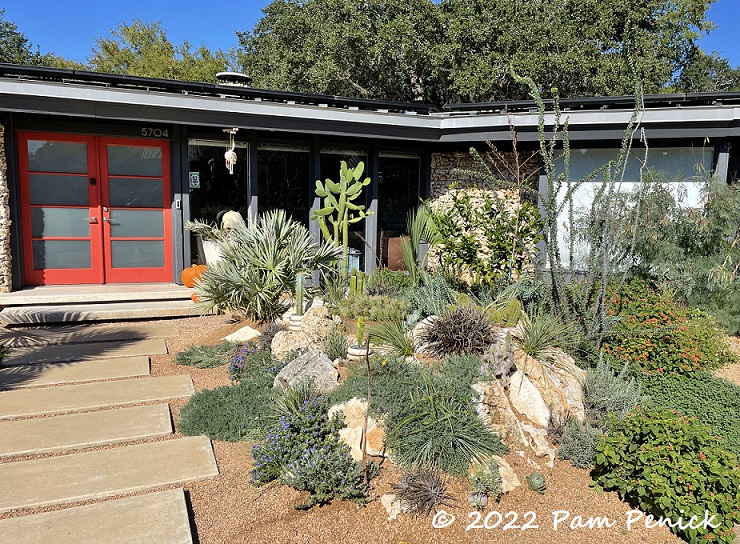
Coleson cheerfully admitted that he’d pulled apart this entire crevice garden after his first attempt felt off to both him and John.
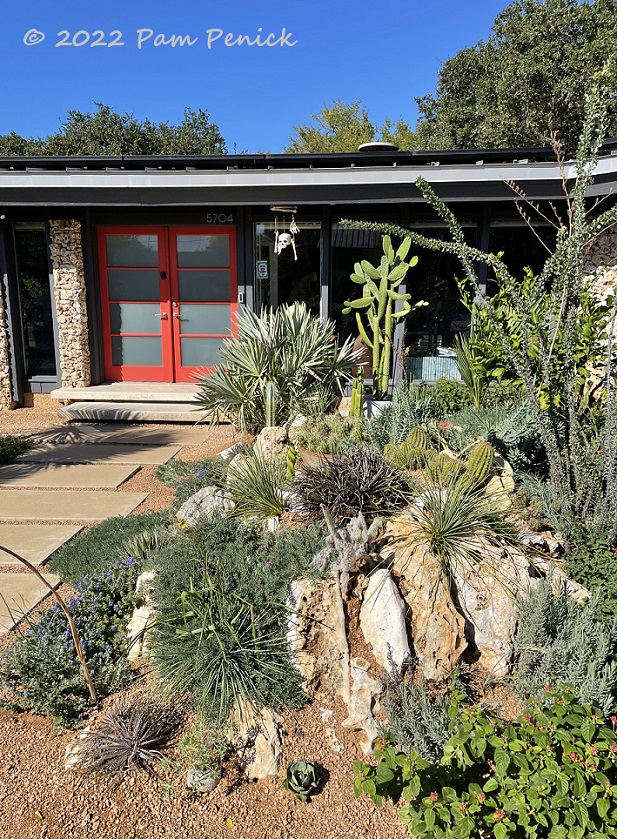
If I recall correctly, he told us he’d originally lined up the vertical rocks parallel to the driveway, rather than perpendicular to it as they are today. But when he realized it wasn’t right, he tore it out and rebuilt it. That’s pride of craftsmanship.
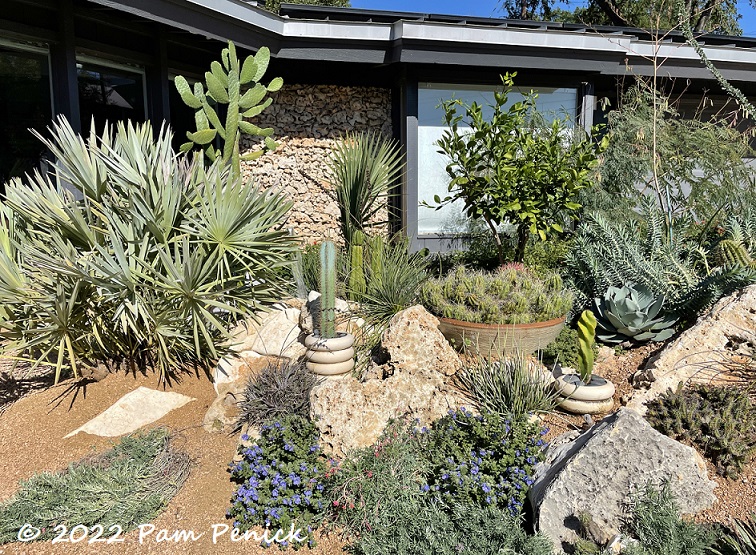
I believe John said that’s a blue saw palmetto (Serenoa repens) at left. It’s even prettier with that upright, skinny prickly pear behind it. Containers tucked among the rocks hold other interesting desert plants, like blue torch cactus, claret cup cactus (I think) in the big round planter in the middle, and spiral cactus.
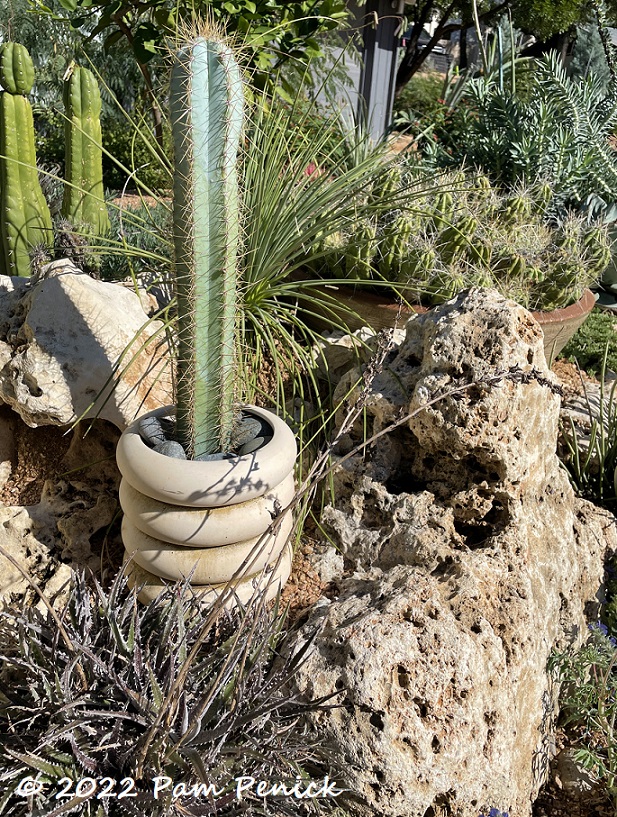
Blue torch cactus (Pilocereus azureus) with dyckia in front
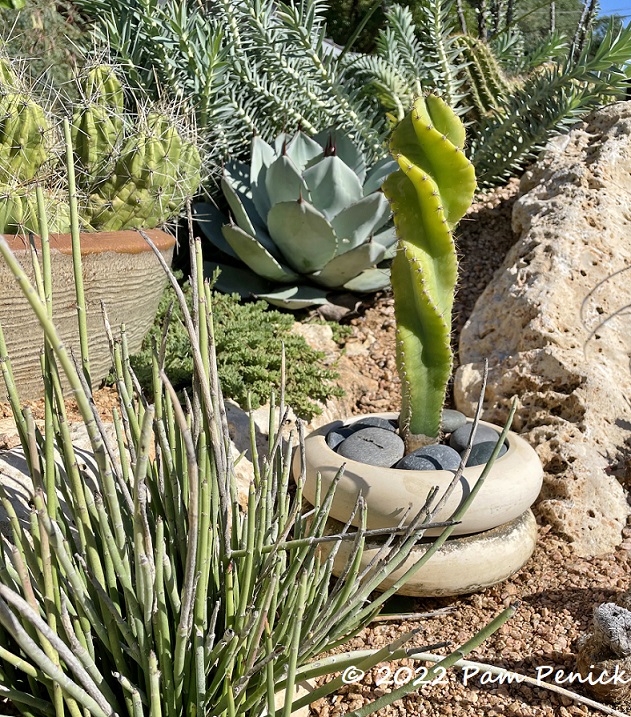
Spiral cactus (Cereus peruvianus ‘Spiralis’)
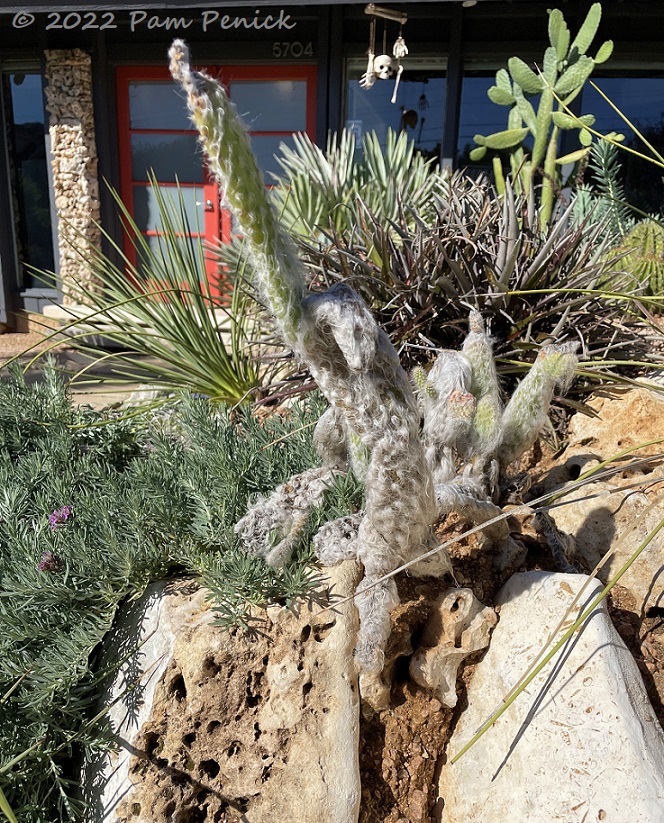
A woolly opuntia makes itself at home in a crevice. On the porch, a dangling skeleton (I visited in late October) echoes its ghostly hue.
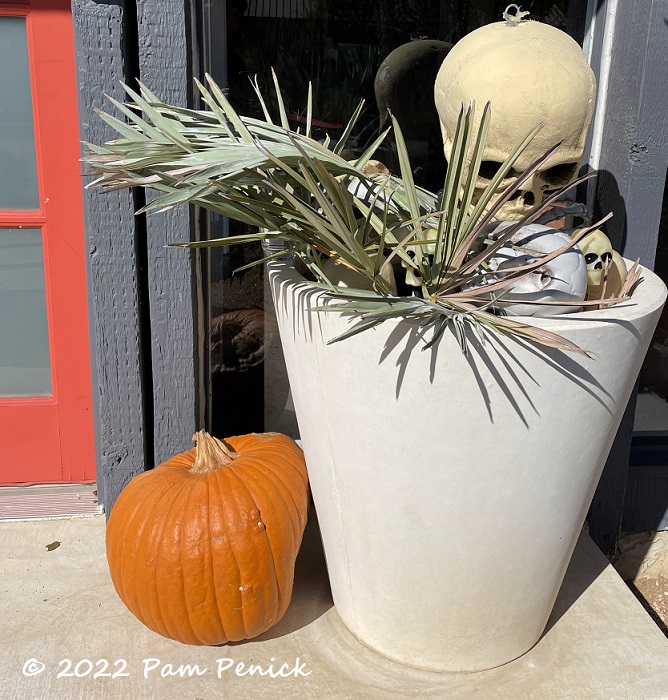
Speaking of skeletons
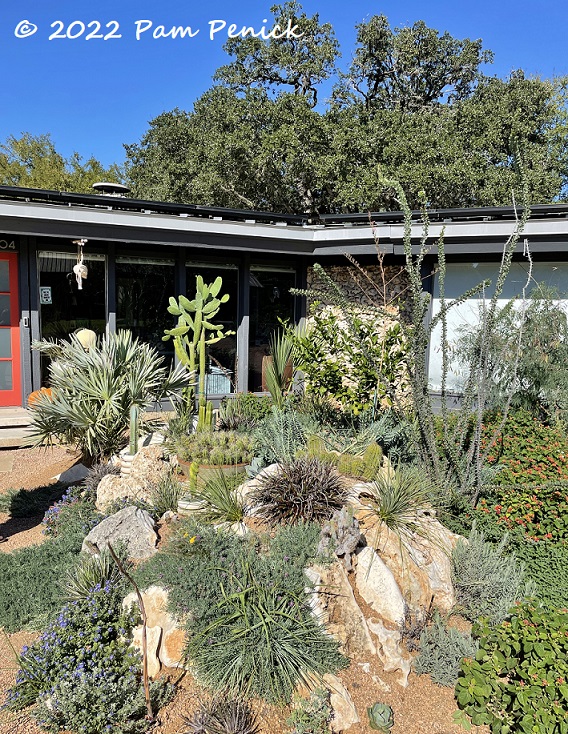
I’m surprised to see as many ocotillo — a plant native to the high desert — around Austin as I do. Coleson’s is one of the happiest I’ve seen, undoubtedly thanks to the excellent drainage of the rocky garden.
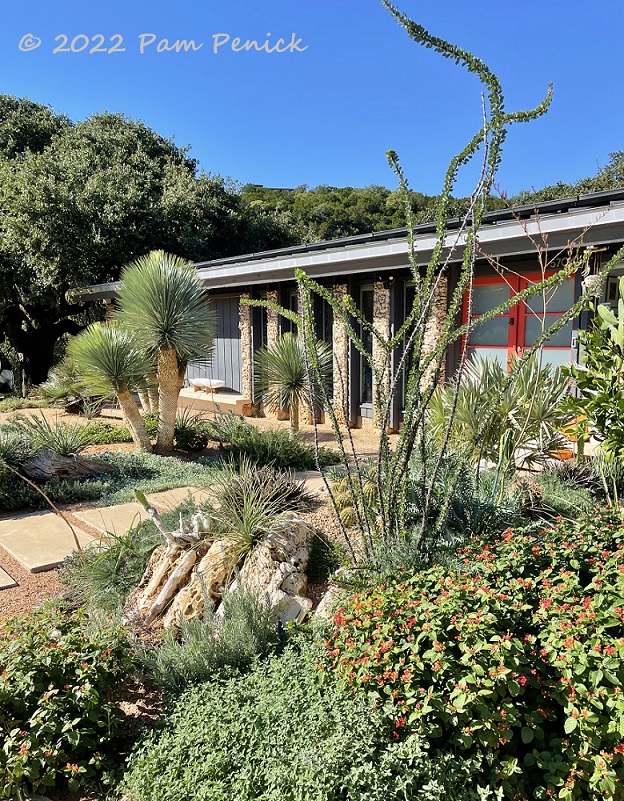
Here’s a better view of it.
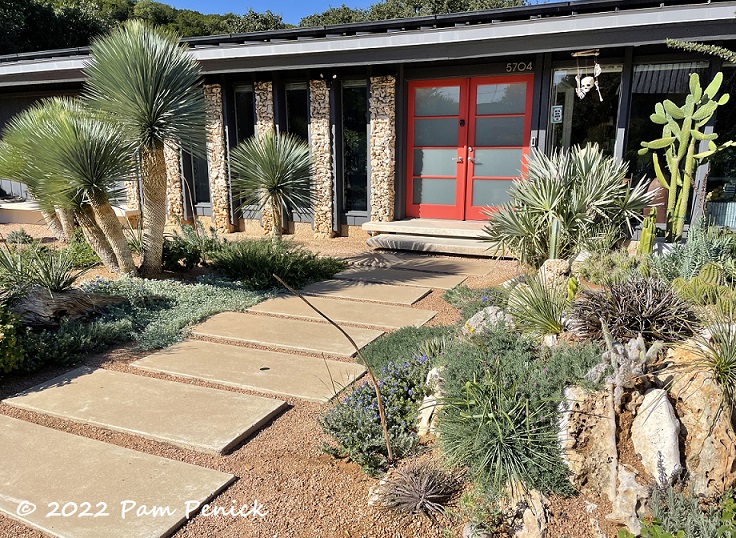
And another of the bristling front walk
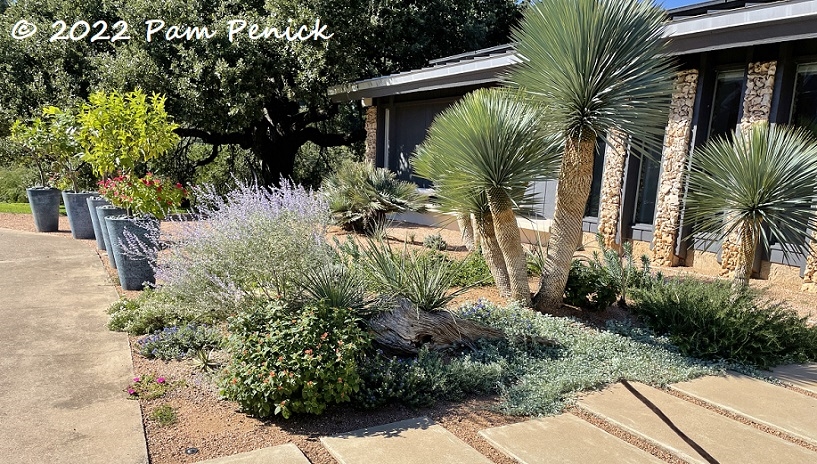
A long view
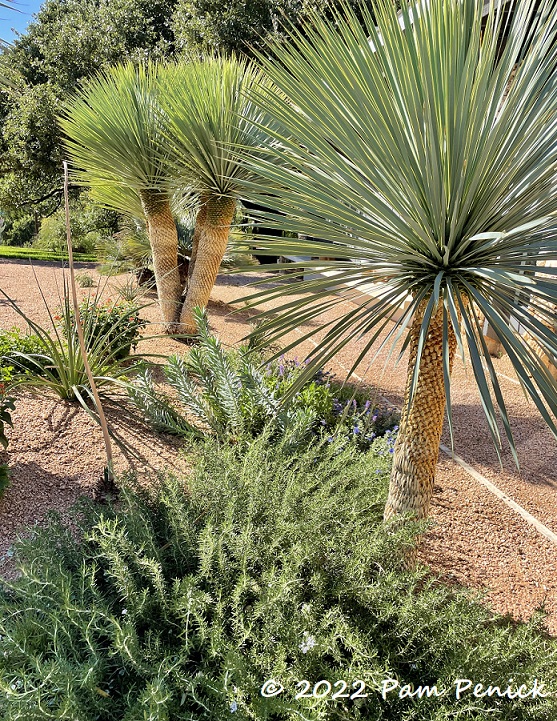
Yucca rostrata and prostrate rosemary
I asked Coleson how his cacti held up after the deep freeze last February. He says, “For the most part, my plant selection leans heavily toward high desert, allowing for both drought and cold tolerance. In a normal winter, I should be able to option out of covering anything, so long as I don’t mind some marginal die-back. The few species I display that are not cold tolerant are in pots, so they may be moved indoors in a significant freeze.”
Still, his garden was brand-new when the freezepocalypse hit. “I covered the crevice garden cacti with varying sizes of black buckets,” he says, “and then finally a series of plastic/blanket covers. My palms lost their fronds temporarily, but by spring I was shocked to find almost everything came back.”
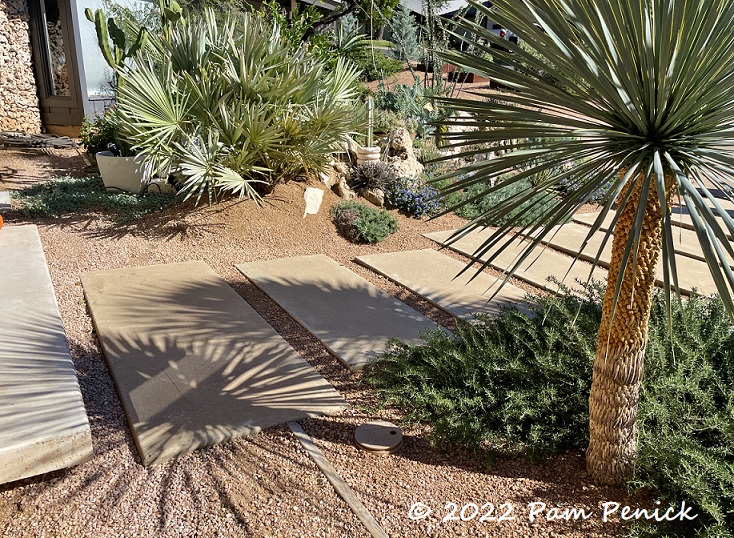
Yucca shadow play
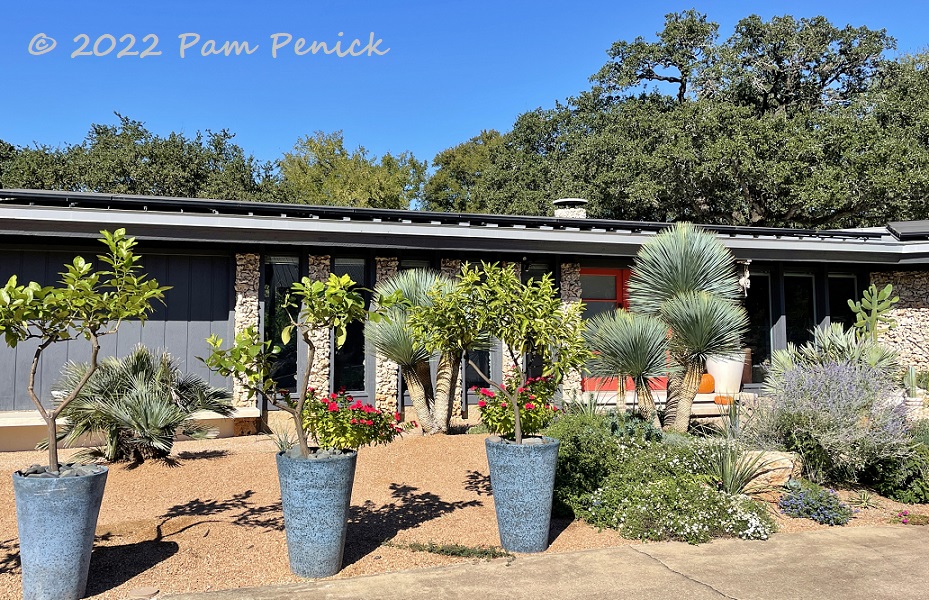
A row of blue pots along the left side of the driveway contain citrus, grapefruit mostly but also a mandarin orange.
Steel planter screening
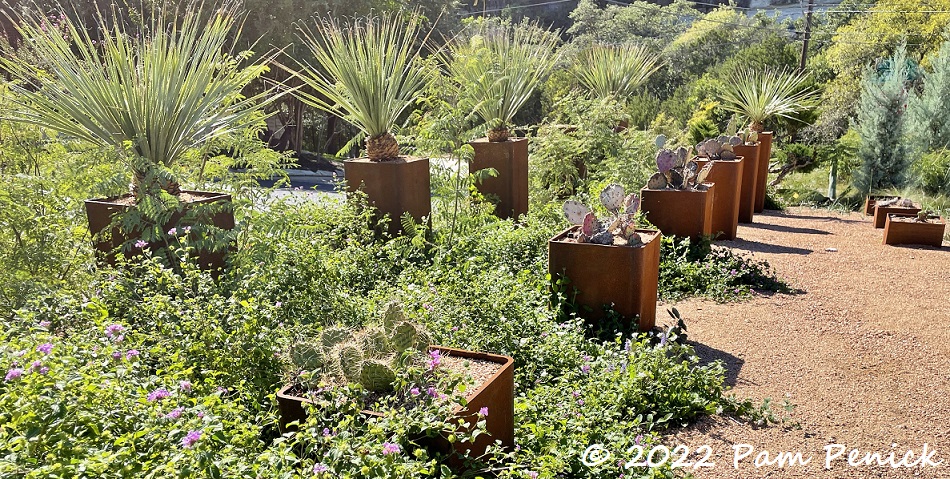
Beyond the driveway, Coleson’s front yard extends on a downhill slope along the street. He and John lined up rusty metal containers in staggered rows and planted them up with sotols, purple prickly pear, and other cacti.
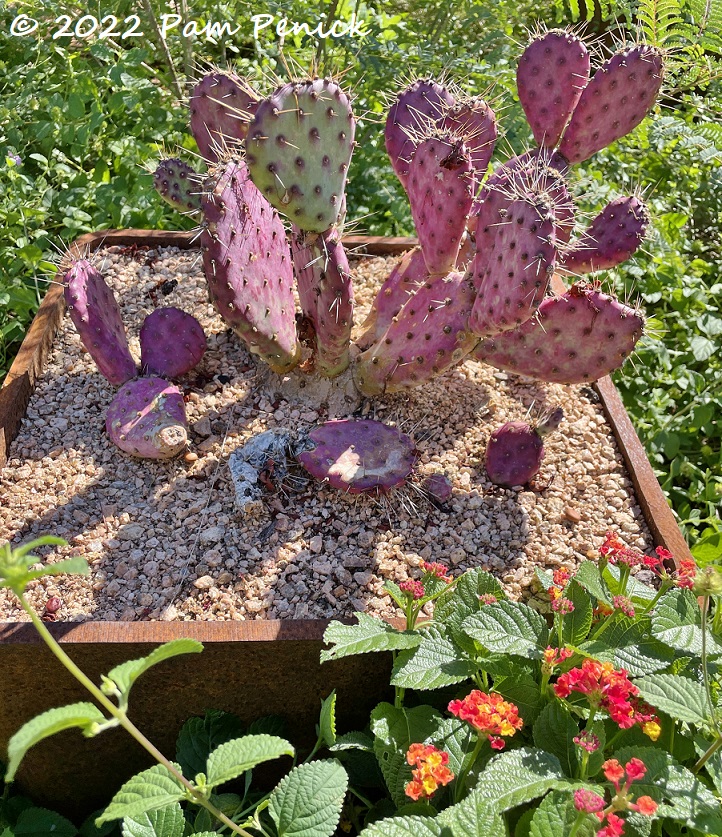
Brilliant coloring on the opuntia
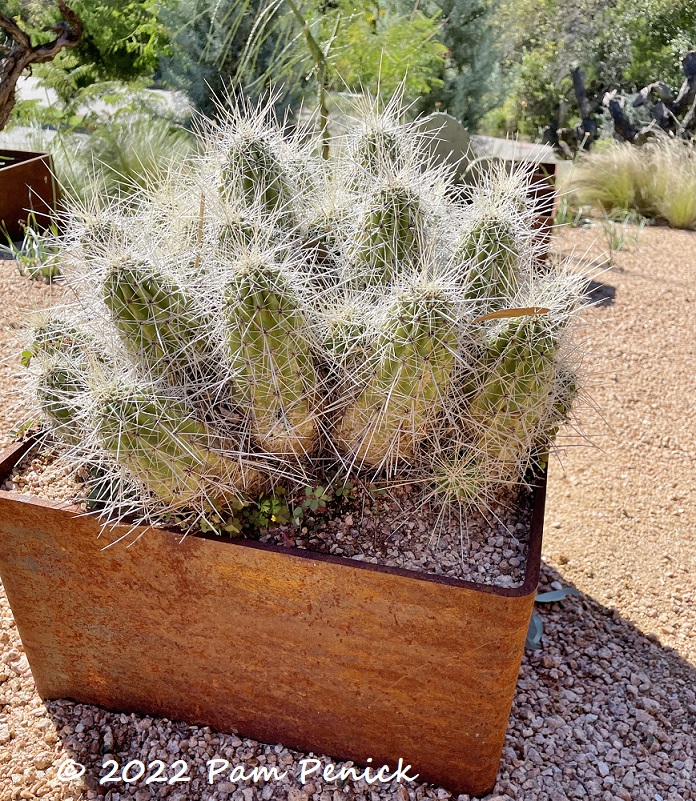
More hedgehog cactus in one of the shortest containers
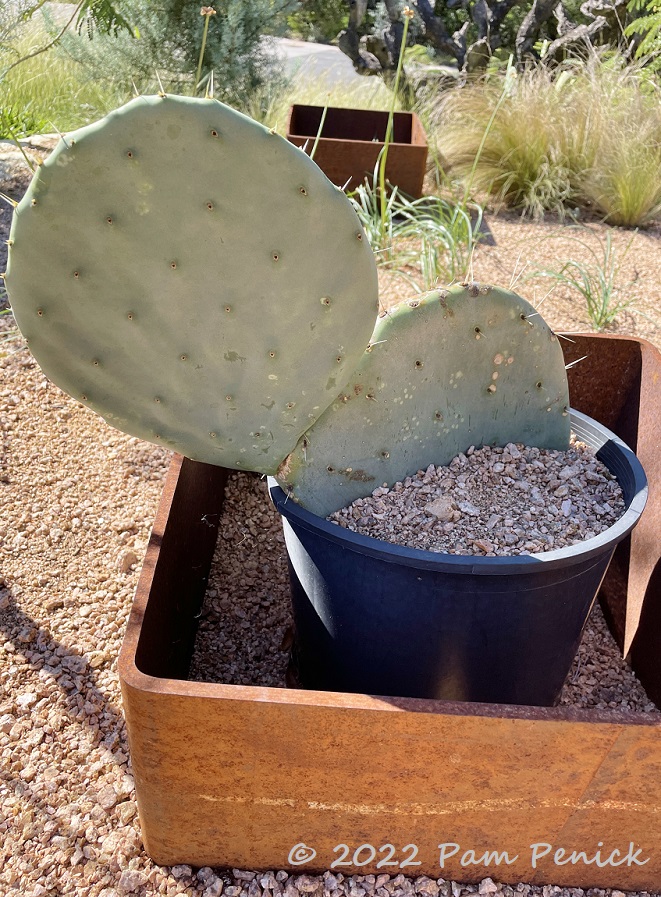
And a lovely, round opuntia waiting to be planted
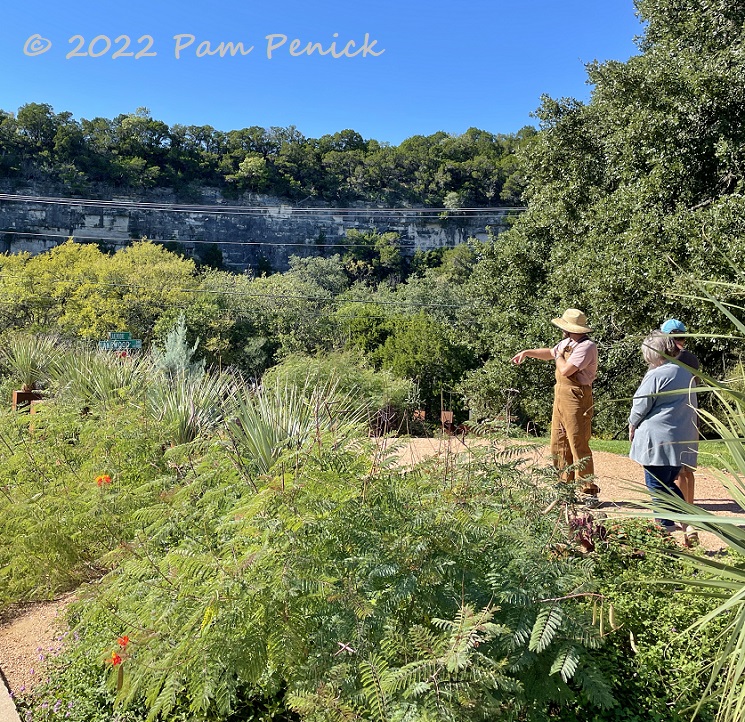
That’s Coleson in overalls and hat, pointing out something to Loree and John. In the foreground, feathery Pride of Barbados still has a few orange flowers in late October. In the distance, the limestone bluff of the Balcones Escarpment along Bull Creek is visible, capped by a fringe of trees — a rocky inspiration for the garden.
I’ll share Coleson’s helpful tips on removing turf and keeping expanses of decomposed granite (DG) free of weeds, for those of us who don’t live in the desert:
“The two foundational issues are dealing first with your historical seed bed and then managing ongoing seed sources. In my garden we carefully removed the St. Augustine lawn along with 1.5 inches of topsoil, which surely contained years of historical seed bed material. Then remained the issue of ongoing seed litter. My front lawn benefits from a relative lack of trees or other tall plants to shed seed into the granite — or for birds to perch on and deposit seed. Further, the front yard is a corner lot that shares only a single border with one neighbor’s lawn and its innumerable weed seeds. If you’re considering decomposed granite or other gravelscape, stand in the area and look up: any trees or plants larger than waist-high are your main seed-litter (and leaf-litter) culprits, second to any nearby yard with weeds.
Do not use a “weed barrier” or similar approaches in a DG/gravelscape. Such barriers do nothing to prevent future weed seeds that come from above, and they do little to deter historical seed beds that eventually come from below.
After eliminating the seed bed and minimizing seed litter sources, there’s still plenty of maintenance to be done. My key maintenance aspirations are:
-Walk the garden with my morning coffee every other day (aspirationally!), and casually nip any new weeds before they have a chance to seed. It’s meditative!
-Weed before doing any leaf blowing, or else you’re now disbursing your own weed litter.
-Weeds love water. When I decide to irrigate a portion of the garden, or when there’s rain, my antennae are up that a weed sweep will be necessary in the coming few days.
-If the weeds get away from you for too long, you had better not be too uncomfortable with strategic use of proper and effective chemical weed deterrents.
After dealing with the foundational weed issues and then a season or two of vigilant maintenance, my DG has very little seed load other than [from my own] plants that I want to propagate.”
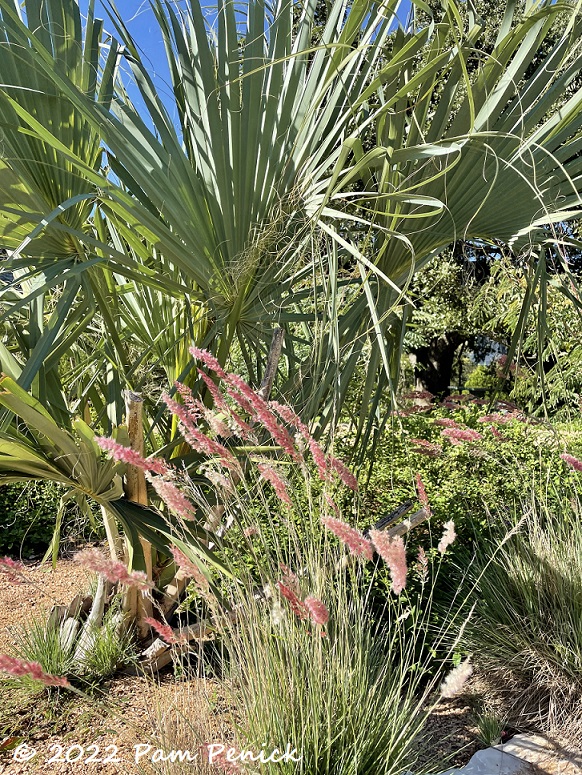
Ruby grass and a palmetto
Hangout space under a massive live oak
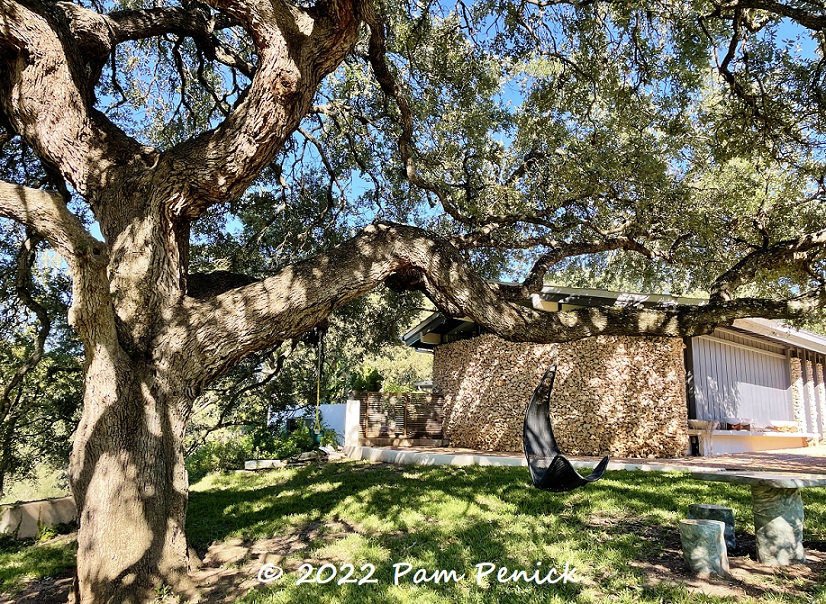
Closer to the house, a massive live oak makes a perfect spot for a bit of shady lawn, a hanging chair, and a green stone table with stools.
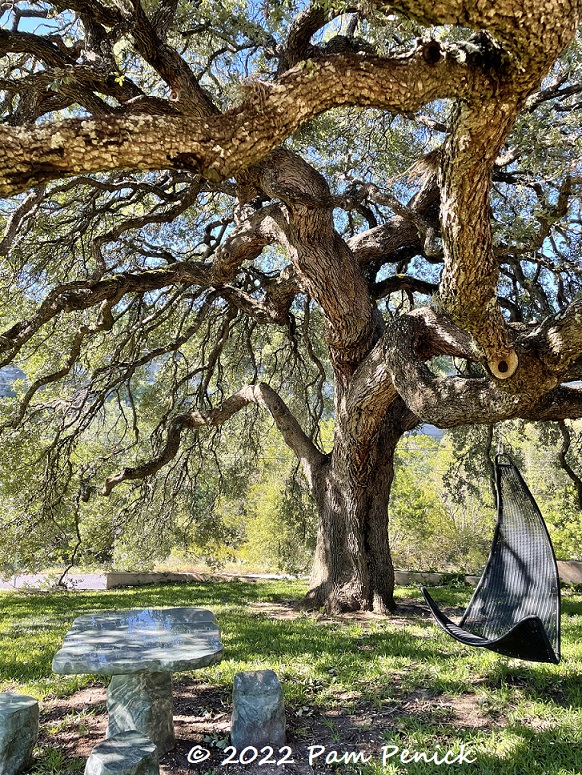
Its spreading limbs are as big around as many tree trunks would be.
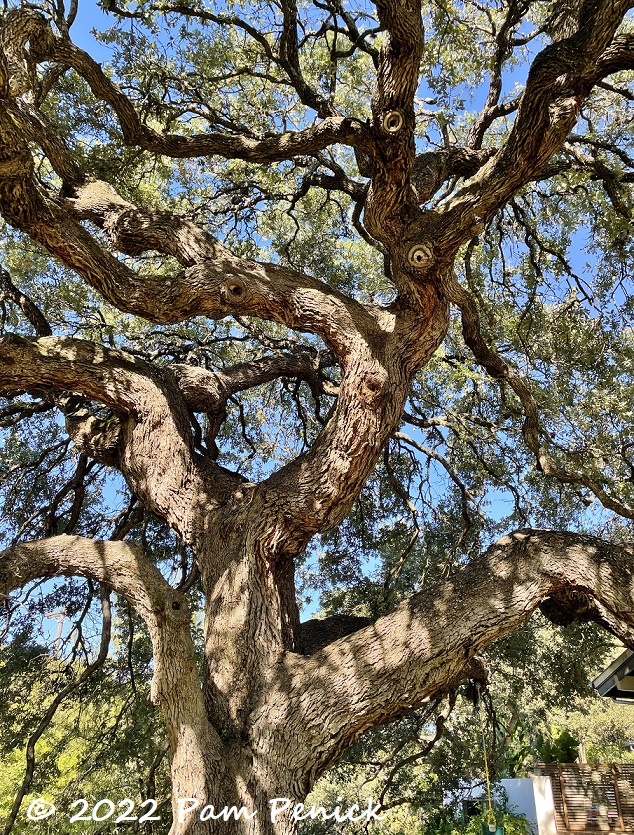
Live oak beauty
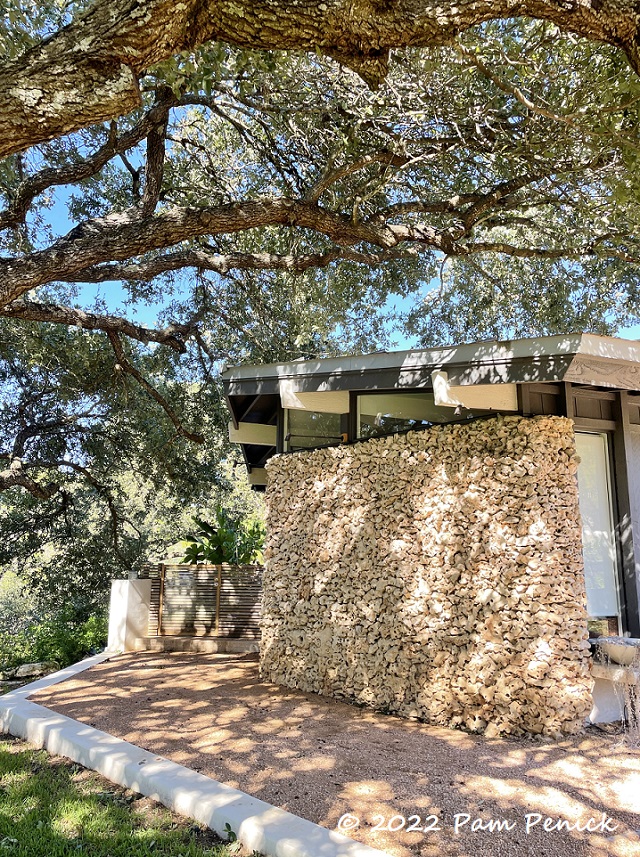
This end of the house really shows off its unique rockwork and midcentury modern lines.
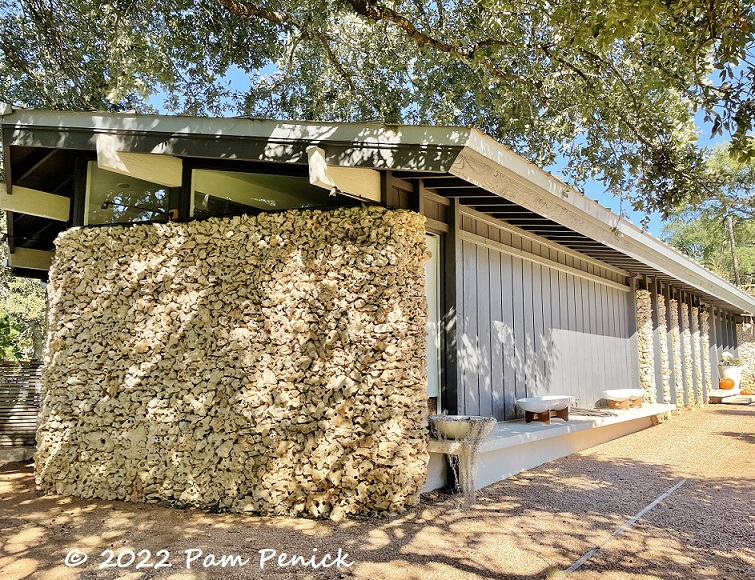
Coleson calls it honeycomb limestone, and it faces not just the exterior but also certain interior walls. In fact the interior of the home blew me away. It’s one-of-a-kind, and while I wish I could share it with you, Coleson and his family deserve their privacy. Here’s a little backstory about the eccentric builder, which Coleson provided:
“The builder and designer was named O.T. Sims. He was not an architect, but instead a custom home builder in the 1960s. He built this home in 1967 for himself and his family and used it as a show home. Accordingly, he appears to have attempted to showcase all of his skills at once in a single building anchored by late ‘60s and early ‘70s design trends. The built-in, 12-person, lava rock dining room table with central 48-inch fireplace is the heart of the house, and something a person either can’t believe or can’t live without.”
Let’s just say I’d fall into the latter category. As Coleson knows, I went nuts when I saw that circular lava-rock table with its wood-burning cooktop and conical, lava-rock fireplace hood, giving off all kinds of tiki vibes. I loved it. The house is fabulous.
Bull Creek cliffs and greenbelt view
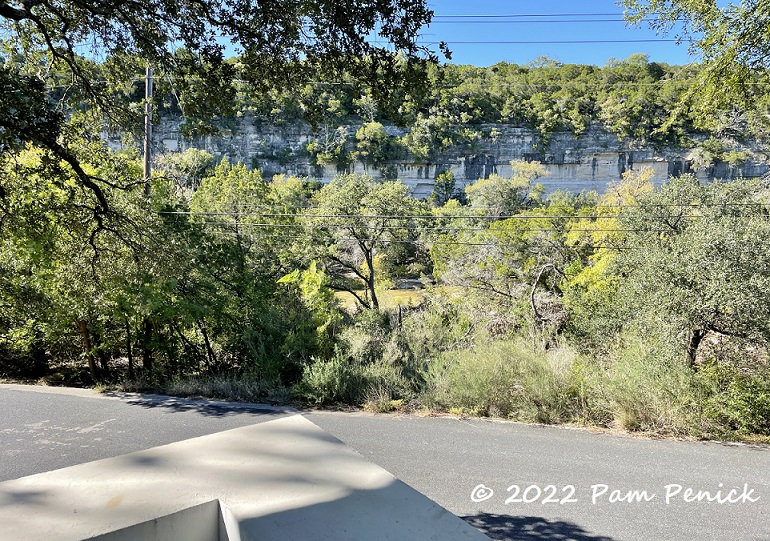
In the backyard, a pool and surrounding deck look over the treetops of Bull Creek and across to that white limestone bluff. A wonderful view.
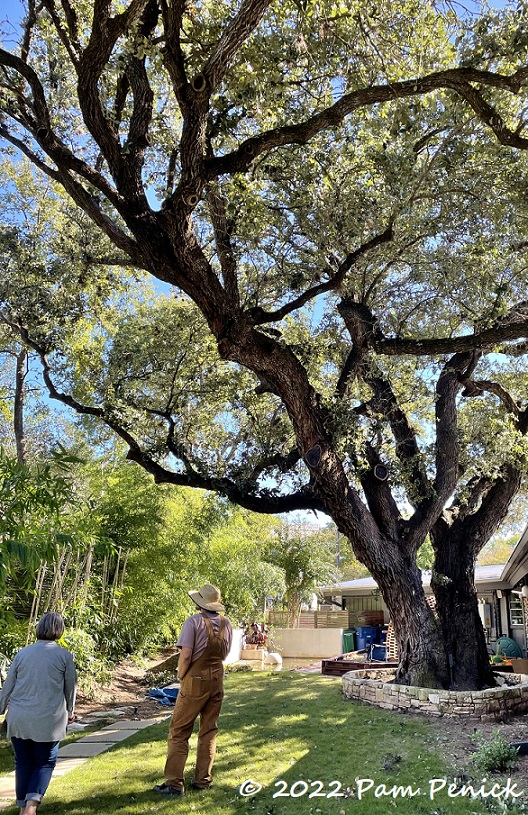
Around in the side yard, another big old live oak holds court.
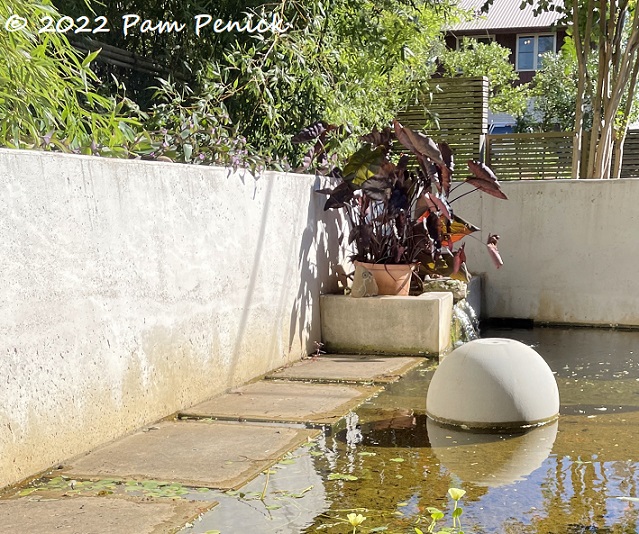
A previous owner built a contemporary-style pond here, edged on two sides with low concrete walls.
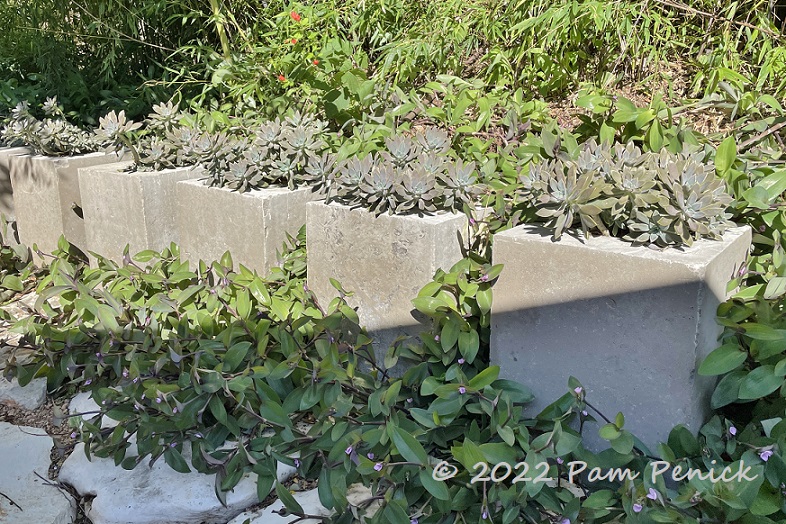
Past the pond, a mod row of Lueders limestone square planters displays ghost plant, a hardy succulent. John explains about their genesis in the comments section of Loree’s post about Coleson’s garden, so check it out for more info.
I’ll close with something Coleson shared with me, which I think sums up nicely the soul-healing value of gardening and of finding a gardening friend:
“I befriended John as a neighbor, who happened to be an experienced gardener and botanist, with greenhouses full of succulents, orchids, etc. Over the years we’d occasionally chat about ideas for my yard. When COVID lockdown dragged on, about April 2020, John and I [started working on] the front island bed. Eventually, mission creep would drag in the entire front yard, as well as some significant work in the back and side yards. About 6 months later we “finished” (do you ever, really?). I joke, I hope not too morbidly, that these are my COVID gardens.
For me it was a 6-month crash course on plants and gardening, with John downloading to me a chunk of his extensive knowledge. In the beginning, not knowing plants or gardening, I would describe to John the shapes, textures, and volume of plants I’d like to see in a given spot, and he would respond with plant options, upkeep considerations, etc. By midway through the 6 months, he could anticipate my aesthetic goals, and I could do a not-too-bad job of anticipating the plant options that could accomplish our goals. By the end of the 6 months, we were completing one another’s sentences.
While it’s true that I compensated John for his time and expertise, that was beside the point. These gardens were just two friends having a good time that got a bit out of hand!”
And there you have it. You never know where a gardening friendship will lead you. Great story, Coleson, and thank you for sharing your garden with us!
__________________________
Digging Deeper
Need design help with your yard? Hire me as your personal garden coach! Maybe you need replacement plant ideas after the big freeze. Or maybe your landscaping has grown tired, and you want fresh curb appeal. Or perhaps you’re ready to get rid of some lawn and create a pollinator garden, bird habitat, or hangout space for you and your friends. I’m here to help! Contact me to let me know what’s going on, and let’s figure it out together. My range is Austin and suburbs within a 25-min. drive of NW Austin, but I’m flexible and can travel farther with a surcharge, so let me know where you are. Weekday morning appts. only.
Come learn about gardening and design at Garden Spark! I organize in-person talks by inspiring designers, landscape architects, authors, and gardeners a few times a year in Austin. These are limited-attendance events that sell out quickly, so join the Garden Spark email list to be notified in advance; simply click this link and ask to be added. Season 8 kicks off in fall 2024. Stay tuned for more info!
All material © 2025 by Pam Penick for Digging. Unauthorized reproduction prohibited.


Thank you for the feature and kind appraisal, Pam. Wonderful photography!
Oh, and John should want me to add: when we removed the St. Augustine and top layer it no doubt made large strides toward deleting the existing seed bed; but it should be said that initially some thoughtful application of chemical deterrent (a few time!) was necessary to more fully irradiate the existing seed bed!
I appreciate your including this detail, Coleson. Like you, I feel herbicide use should be as minimal and thoughtful as possible. But for eliminating Bermudagrass or other tenacious weeds, it is a tool that can be make-or-break in terms of even having a garden.
You’re welcome, Coleson, and thank YOU (and John) for sharing with me!
Wow, I am blown away by the gardens, they are stunning. It looks so established, not at all new. I don’t think I have seen a crevice garden before, so glad you were allowed a visit. Gets me to thinking that similar small crevice gardens could be spread throughout a yard in appropriate locations, to mix rock in with a current landscape. You really need to write a book Pam about these fabulous gardens you visit, they are so inspirational!
Thanks, Heidi. I would love to do that!
Pam this is such a comprehensive look at the garden and the process, just wonderful. I kind of want to delete my post and just direct people here! Thank you for doing justice to what Coleson and John created.
Thank you, Loree. But no way on deleting your own unique perspective! I delved deep on this one because it’s such an unusual garden for our area, and I knew local readers would be inspired by what Coleson and John created.
What a spectacular garden! Thanks so much for sharing this Pam! Hope they’ll let me visit next time I’m Austin way…
I’d love to visit again WITH you, Panayoti. Let me know next time you’re coming to Austin!
I’d be honored!
For me this project was the culmination of my love of plants that started at DBG nearly 50 years ago.
Love that, John. Mine started at the Lady Bird Johnson Wildflower Center right after I moved to Austin 28 years ago.
It’s a remarkable garden from every angle. It may have started as a pandemic project but Coleson’s vision and John’s expertise (and plants) made it a masterpiece, perfectly suited to the home’s architecture. Few houses and gardens I’ve seen sit together so comfortably.
They really do, don’t they?
I love this post on multiple levels! These two have created a beautifully artistic and amazingly mature looking garden, and you’ve done a wonderful job photographing, sharing and educating us as to what’s possible in our area. You know just the right questions to ask gardeners, and Coleson’s thoughtful answers are very informative. To be honest, I’d never given crevice gardens a second thought because the ones I’ve seen were filled with alpine plants, but seeing the desert twist puts them in a whole new light. Perhaps what I love most is the fact that these two neighbors conspired and built something that must elevate the entire street and neighborhood. Having a gardening buddy for a neighbor is the best!
“Perhaps what I love most is the fact that these two neighbors conspired and built something that must elevate the entire street and neighborhood.”
I love that part of the garden story too, Maggie. Thanks for the lovely compliments.
Lovely house and crevasse garden! I love learning things on your blog. I did not know that I had Cylindropuntia leptocaulis in a pot. I ended up with a piece of it stuck to my sleeve from a hike and tossed it on top of a planter. It is now about 4 feet tall… and bloomed around Christmas.
My friends *hate* it, as it likes to reach out and grab you. It’s a real testament to why throwing plants on top of dirt can be an ineffective disposal mechanism… 😀
Funny, Tim! That’s obviously a plant that doesn’t slink away with a whimper.
Thanks, Pam, for highlighting this garden! It’s my favorite garden in Austin! The first time I drove past it I had to pull over and just gape at it with my mouth hanging open! On one of my frequent drive-bys, Coleson and John were both out in the yard and my instinctive response was to get out of my truck and APPLAUD!! One of my favorite elements is the relationship to the rock cliffs that stand by looking on from across the creek. And the crevice gardens. And the cool, steel square planters that all line up on top… the rhythm, the geometry!! This yard inspires me SO MUCH!
And you made our day with that visit! While yours was the most memorable visit, we were blessed in a time of isolation to be exposed to more people in our neighborhood and beyond than either of us had met in years. Working so publicly on a project like that gave us such a social advantage that we almost felt badly that we weren’t struggling with the lockdown as so many were. Thanks to you and everyone who dropped by for being part of the project with us!
You must be a kindred spirit, Christi, because that sounds like the kind of reaction I’d have to a cool garden drive-by. Well, that plus yanking out my camera to take a million pictures while hoping no one thinks I’m a stalker. Thanks for sharing your experience with this garden!
Love getting to see this garden!
Thanks, I’m happy to be able to share!
All of those stones are magnificent. Only such plants that were used could take my eyes away from the stone. Such a great garden. It shows that love and passion can transform any plot. I thoroughly enjoyed being drawn into such a space.
Lisa, the stonework is wonderful. And the scale! Thanks for your comment.
The finished garden and your thorough account is a master class in garden making. I love drilling down into the “historical seed bed” and prepping for planting. And adapting the crevice garden idea from display of tiny treasures to deploying its principles on this heroic scale is just a brilliantly innovative move that shows such regional intelligence and style — and what a showcase for your limestone! One day maybe you’ll be entrusted with documenting that indoor lava rock table and fireplace too…
A heroic scale — I love that description, Denise. Thanks for your always spot-on take.
And you made our day with that visit! While yours was the most memorable visit, we were blessed in a time of isolation to be exposed to more people in our neighborhood and beyond than either of us had met in years. Working so publicly on a project like that gave us such a social advantage that we almost felt badly that we weren’t struggling with the lockdown as so many were. Thanks to you and everyone who dropped by for being part of the project with us!
John, thanks so much for introducing us to Coleson, and to both of you for sharing your one-of-a-kind gardens with us!
What a gorgeous crevice garden! Truly memorable. The home and rest of the gardens are equally beautiful, but that crevice garden is the crown jewel for sure. Another inspiring featured garden – I love this blog. Wonderful photos as well, you are truly a multi-talent, Pam. Thank you.
Thanks, Skottie, for your very kind compliment. I have so much fun meeting gardeners and seeing their creations. There are a lot of creative people out there, including yourself!
Wonderful! Coleson’s house looks great, and what a lovely story how it came about. John has, to me, always been some sort of pseudo-magical green thumbed plant unicorn. It’s wonderful to get to see projects he’s contributed to!
“pseudo-magical green thumbed plant unicorn” — Plant unicorn! I now have the perfect nickname for John. 🙂
Terrific report Pam ! I’m sure it’s one I will return to frequently. I love the ‘mission creep’ aspect of the story-though my garden is minuscule in comparison I find myself constantly eyeing areas that adjoin projects that I have actually planned -they usually fall prey to the shovel.
Mission creep happens to us all — even patio gardeners, I bet. 😉 Thanks for your comment, Kathy.
An incredible posting about an amazing garden, Pam. So much work with the building, taking apart, and rebuilding–obviously worth the effort. There are so many lessons for any gardener to take away from this story. Oh, and I would love a peep into that house! P. x
Lots of great lessons from their story, for sure. I’m glad you enjoyed the post, Pam!
O M F G
This is my favorite new garden in a while! Taking many notes between your post & Lorrie’s. I have so many questions too— is there any irrigation or just hand watering as needed? I’m so curious about the silver saw planted right next to the rostratas— I love the effect but I would have expected differing irrigation requirements would make that difficult but maybe the soil prep varies?
Honestly, I have so many technical questions about bed prep and plant selection and it looks like there’s a lot of interest from these comments— maybe John & Coleson could give a Garden Spark talk on the subject?
I’ve had that exact same thought about a Garden Spark talk, Lori. Thanks for seconding the idea.
Re: the watering, I didn’t end up including this, but Coleson did answer my question about whether he ever had to irrigate with such dry-loving plants:
“I think I need to make a distinction between ‘having to’ and ‘wanting to’ irrigate. As far as ‘having to’ irrigate, the majority of my plants are intentionally drought tolerant, to the extreme. I could probably never water again, and the bulk of my yard would do just fine with the lack of water. But because the garden is young — particularly the few palms that I’d like to size up — I’m still doing a bit of irrigating to let things establish and/or prompt growth. I expect that as the garden matures, I’ll have less and less reason to water. In fact, watering less is a key piece of weed maintenance.”
I noticed that his garden has irrigation boxes, so I’d guess a sprinkler system is in place. The proximity of the silver saw palmetto and yucca rostratas is a good question. Inquiring minds want to know!
Coleson didn’t much go into the main part of my job which was the logistics of making it all work together. He often described his frustrations with the whole process and I can’t remember the term he used so hopefully he’ll chime in. Something along the lines of two steps forward three steps back. For instance, the rostratas were the first thing we planted…only we hit the top of an uncollapsed septic tank 6″ down and had to collapse all of that and then determine whether he had sewer at all since the house wasn’t being charged for it. So at least 3 of those rostratas are on a 3′ deep bed of sandy loam buried in a concrete box. Additionally, we had to pretty much dig up the sprinkler in that entire front bed, move at least one valve, reroute the main to make sure nothing was under the crevice bed that might break in the future. Add to that the fact that the green hedges were the drip line for the whole roof in the front and we needed a plan to ensure the walkway could drain all the water away from the house without washing away. It works perfectly (knock wood). There is one zone along that whole front of the house, but the front also gets all the drip from the roof and, to allow flexibility for how the zone is used to address just the issues you bring up, we put in 3 separate heads for drip lines that could be used to water everything that’s critical, by just turning off all the spray heads and running the zone on the drippers. Those heads are hidden under the corners of the front stairs. So far I don’t think he’s used them.
Also, bear in mind that Serenoa repens grow in deep super well drained sand that dries out easily. They’re a pretty tough plant in our climate and readily adaptable to the same watering regime as rostrata with the correct soil prep. I’m not sure how often Coleson watered but I’d imagine this year it wasn’t all that necessary.
Thanks for getting into the nitty-gritty of the construction process and irrigation challenges, John.
A truly inspiring garden and such a labor of love. So unique and really compliments the style of the home especially in contrast to the before photo. I just love how they took a concept from another part of the country and adapted it to zone appropriate plants and made it work with the local landscape.
Me too, Karin. And for a first crevice garden (at least for Coleson), they did an incredible job artistically.
Rock placement in the crevice garden is very natural looking – well done! The pics are inspiring. Perhaps this will persuade me to finish my own attempt at a crevice garden.
I hope you’ll come back and link to a blog post about yours when you finish it, Hans.
So well done, yet diverse. Great rock and plant placement, which must offer living impact all year by relying on evergreen accents over perennial-based crevice plantings. Good address of weeds in large gravel areas, as some I knew (his take on weed fabric) but others I didn’t (historical seed bed material). And definitely, “compensated John for his time and expertise, that was beside the point. These gardens were just two friends having a good time that got a bit out of hand!”
The historical seed bed concept makes sense, and I’m glad he shared that. Also his observation that an open, treeless garden is less vulnerable to bird-sown weeds, so save your gravel expanses for places like that.
Love this so much–thank you!
I’m glad you enjoyed the virtual tour!
[…] weeks ago Coleson Bruce invited me back to his garden to see it in spring flower. I’d first visited Coleson’s garden last fall — a garden unlike any other I’ve seen in Austin or even Texas. Colorado-style crevice […]